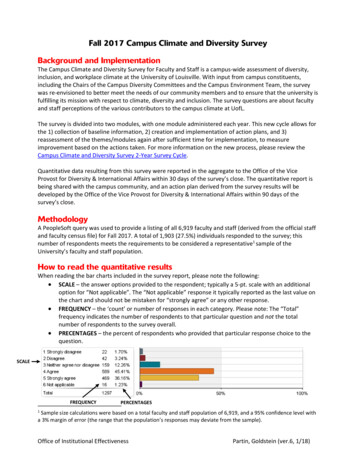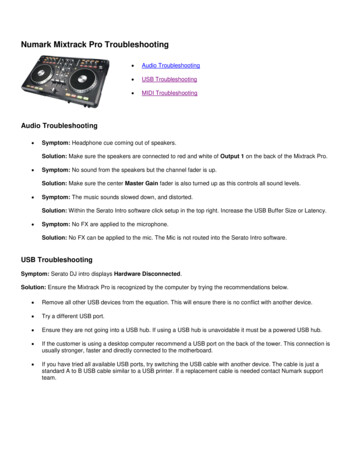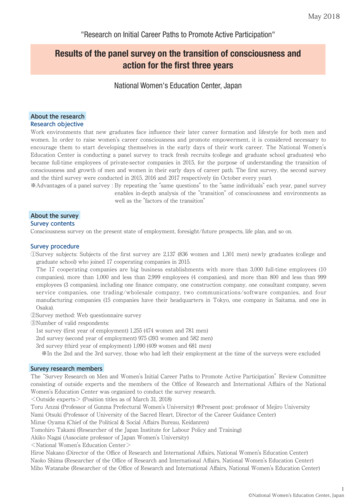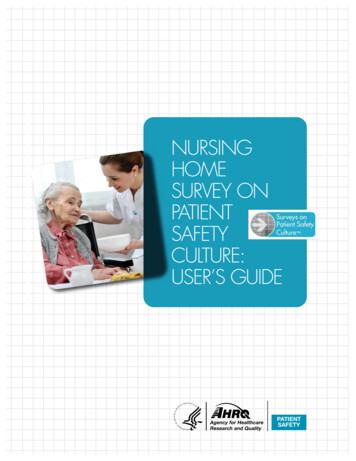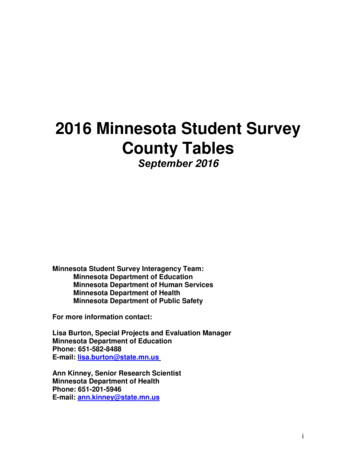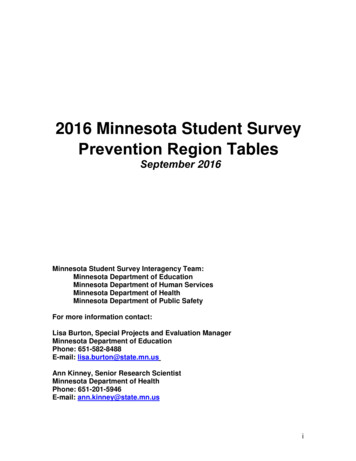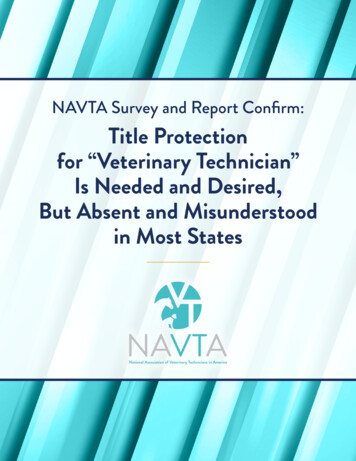
Transcription
NAVTA Survey and Report Confirm:Title Protectionfor “Veterinary Technician”Is Needed and Desired,But Absent and Misunderstoodin Most States
Table of ContentsIntroduction. 1This report was prepared byNAVTA’s Veterinary NurseInitiative (VNI) Working Group.The VNI Working Group workswith state veterinary technicianassociations and others interestedin pursuing the VNI goals. Forinformation about the VNI, pleasevisit www.veterinarynurse.orgAbout VNICurrent Licensing and Educational Requirementsfor Veterinary Technician. 2Current State of Title Protection in State Practice Acts. 4NAVTA Veterinary Nurse Initiative TitleProtection Survey Results. 4Veterinary Field Awareness of Title Protection Laws. 8Title Protection Violations—Notifying State Boards. 10Enforcing Title Protection Within thePlace of Employment. 11Why is Title Protection Important to You?. 12Recommendations. 13PROFESSIONAL STANDARDSPromoting a standardcredential with educationalstandards in the USPUBLIC RECOGNITIONEstablishing professional identitythrough public education and titlerecognition to contribute to publicsafety/protection.PROFESSIONAL RECOGNITIONClarifying the value, scope ofpractice, and title, delineatingthe credentialed veterinarytechnician/nurse role.EXPANDING CAREERPOTENTIALSDefining the role of ourprofession in all areas of practiceto maximize potentials.Conclusion. 16
1 NAVTA Title Protection Survey and Report FindingsIntroductionThe veterinary technician profession has long been challenged by a lack of cohesion and standards in the UnitedStates. As a result, the title of “Veterinary Technician” is used inconsistently and, often times, incorrectly, and suffersfrom a lack of clarity and understanding, both within the veterinary world and among consumers.For example, a consumer may not know the specific differences between licensing requirements for registered nurses,physician assistants, or nurse practitioners, but consumers have an underlying understanding that there is a standardof professional education that individuals with these titles hold. This same consumer understanding needs to exist forthe veterinary profession, where Veterinary Technicians are clearly differentiated from Veterinary Assistants and otherparaprofessionals on the veterinary team.To understand the current environment of the varyinglicensing requirements and standards throughout theTo understand the current environment of theUnited States, the NAVTA Veterinary Nurse Initiativevarying licensing requirements and standardsTask Force reviewed the current veterinary practicethroughout the United States, the NAVTAact language for each state on title protection forVeterinary Nurse Initiative Task Force reviewed theveterinary technicians. In addition, a survey of currentcurrent veterinary practice act language for eachveterinary technicians was conducted to learn aboutstate on title protection for veterinary technicians.the profession’s feelings and experiences surroundingtitle protection for veterinary technicians. This reportcontains the findings of the Task Force’s work, as well as the results from the survey, and recommendations on furthersteps to take to better promote title protection and standards for the veterinary technician profession.TABLE 1. Recognized veterinary technician credentials in the United StatesCertified VeterinaryTechnician (CVT)Registered VeterinaryTechnician (RVT)Licensed VeterinaryTechnician (LVT)Licensed Veterinary MedicalTechnician sotaMissouriNew YorkMississippiNew MexicoNorth DakotaMontanaNorth CarolinaSouth CarolinaNew HampshireOhioTexasNew JerseyOklahomaVirginiaOregonSouth DakotaWashingtonPennsylvaniaWest VirginiaRhode IslandUtahVermontWisconsinWyoming
2 NAVTA Title Protection Survey and Report FindingsCurrent Licensing and Educational Requirementsfor Veterinary TechniciansCurrent standards for obtaining a veterinary technician credential in the United States involves two steps:1. Obtaining an associate or bachelor degree in veterinary technology or nursing from an institution accreditedby the American Veterinary Medical Association (AVMA) Committee on Veterinary Technician Education andActivity (CVTEA), and2. Passing the American Association of Veterinary State Boards (AAVSB) Veterinary Technician National Exam(VTNE).Recognized veterinary technician credentials in the United States include: Certified Veterinary Technician (CVT) Licensed Veterinary Technician (LVT) Licensed Veterinary Medical Technician (LVMT) Registered Veterinary Technician (RVT)Use of these credentials in each state is detailed in Table 1. Those who have not obtained a Veterinary Technician credential are considered Veterinary Assistants in most states.TABLE 2. Title Definition in State Practice ActsNo Title DefinitionLimited Title DefinitionGeneral Title DefinitionThe practice act does not provide adefinition for veterinary technicians.The practice act defines specifictitles for veterinary technicians,such as “Certified VeterinaryTechnician,” “LicensedVeterinary Technician,”or “Registered VeterinaryTechnician.”The practice act defines the general term“Veterinary Technician” as those that arecredentialed within the specified state.13 U.S. states and jurisdictionsdo not define what a veterinarytechnician is within the veterinarypractice:15 U.S. states and jurisdictionshave limited title definition:24 U.S. states and jurisdictions providegeneral title definitions:Alabama (LVT), Alaska (LVT), Arkansas(CVT), California (RVT), District ofColumbia, Delaware (LVT), Georgia (RVT),Idaho (CVT), Iowa (RVT), Kentucky (LVT),Michigan (LVT), Mississippi (CVT), Nevada(LVT), New Mexico (RVT), New York (LVT),North Carolina (RVT), North Dakota (LVT),Oklahoma (RVT), Oregon (CVT), SouthDakota (RVT), Utah (CVT), Virginia (LVT),Washington (LVT), Wisconsin (CVT).Colorado (CVT)*, Connecticut (CVT),Florida (CVT), Hawaii (RVT)**,Massachusetts (CVT), Minnesota(CVT), Montana (CVT)***, NewHampshire (CVT), New Jersey (CVT),Puerto Rico, Rhode Island (CVT),Vermont (CVT), Wyoming (CVT).Arizona (CVT), Illinois (CVT),Indiana (RVT), Kansas (RVT),Louisiana (RVT), Maine (LVT),Maryland (RVT), Missouri (RVT),Nebraska (LVT), Ohio (RVT),Pennsylvania (CVT), SouthCarolina (LVT), Tennessee(LVMT)****, Texas (LVT), WestVirginia (RVT).* The state of Colorado is currently undergoing a sunrise reviewprocess to establish state governed credentialing** The state of Hawaii Veterinary Technology Practice Actdoes not define “Veterinary Technician” in their definitionsection. Instead, it specifies title protection in the practice andqualification section ([§472-2]).*** The state of Montana currently issues private certificationbut has passed legislation to establish Licensed VeterinaryTechnicians to be implemented starting 2023.**** The state of Tennessee defines “Licensed VeterinaryTechnician” in the definition section of the practice act, butfurther specifies the title “Veterinary Medical Technician” in rules(Chapter 1730-03).
3 NAVTA Title Protection Survey and Report FindingsTABLE 3. Title Protection in State Practice ActNo Title ProtectionLimited Title ProtectionGeneral Title ProtectionThe practice act does not include languagerestricting the use of titles related to “veterinarytechnician” to those that are credentialed withinthe specified state.The practice act protectsthe specific title of “CertifiedVeterinary Technician”, “LicensedVeterinary Technician”, or“Registered Veterinary Technician”,restricting its use to those that arecredentialed within the specifiedstate.The practice act protectsthe general title “veterinarytechnician” restrictingits use to those that arecredentialed within thespecified state.The use of the title “veterinarytechnician” is not restricted.12 U.S. states and jurisdictions have noprotection as the title is not defined in thepractice act and thus unregulated by the state:10 U.S. states and jurisdictions areclassified as having limited titleprotection in their practice act:11 U.S. states have generaltitle protection in theirpractice act:Colorado (CVT)*, Connecticut (CVT), Florida(CVT), Massachusetts (CVT), Minnesota (CVT),Montana (CVT)**, New Hampshire (CVT), NewJersey (CVT), Puerto Rico, Rhode Island (CVT),Vermont (CVT), Wyoming (CVT).Illinois (CVT)***, Louisiana (RVT)***,Maryland (RVT), Michigan (LVT),Missouri (RVT)***, Nebraska (LVT),Pennsylvania (CVT)***, Texas(LVT)***, Utah (CVT), West Virginia(RVT)***Alabama (LVT), Arkansas(CVT)****, California(RVT)***, Delaware (LVT),Georgia (RVT), Hawaii(RVT)***, Indiana (RVT)***,Nevada (LVT), New York(LVT), Oklahoma (RVT)***,Tennessee (LVMT)****19 U.S. states and jurisdictions regulateveterinary technicians but have no titleprotection stated in the practice act:Alaska (LVT), Arizona (CVT), District of Columbia,Idaho (CVT), Iowa (RVT), Kansas (RVT), Kentucky(RVT), Maine (RVT), Mississippi (CVT), NewMexico (RVT), North Carolina (RVT), NorthDakota (LVT), Ohio (RVT), Oregon (CVT), SouthCarolina (LVT), South Dakota (RVT), Virginia(LVT), Washington (LVT), Wisconsin (CVT)* The state of Colorado is currently undergoing a sunrise reviewprocess to establish state governed credentialing.** The state of Montana currently issues private certificationbut has passed legislation to establish Licensed VeterinaryTechnicians to be implemented in 2023.*** These states also restrict the use of credential abbreviations(i.e. “CVT”, “LVT”, “RVT”, or “VT”) to those who are credentialedby the state.**** The states of Arkansas and Tennessee protect the term“technician” in addition to “veterinary technician” to berestricted to credentialed veterinary technicians.TABLE 4. Penalty Procedures for Title Misuse in State Practice ActsNo PenaltyPenaltyThe practice act does not specify any penaltyassociated with non-compliance with titleprotection laws.The practice act has written language specifying a penaltyassociated with non-compliance to title protection laws.47 U.S. states and jurisdictions have nopenalties for non-compliance with titleprotection laws.5 U.S. states issue penalties to individuals misrepresentingthemselves as a veterinary technician:Delaware (LVT): FineIllinois (CVT): Class A misdemeanorIndiana (RVT): Class A misdemeanorOklahoma (RVT): Fine and/or imprisonmentTennessee (LVMT): Class B misdemeanor
4 NAVTA Title Protection Survey and Report FindingsCurrent State of Title Protection in State Practice ActsThe NAVTA Veterinary Nurse Initiative Task Force reviewed the veterinary practice act language from every state inthe United States as of November 2021. (The term “practice act” in the context of this report includes both legislativeacts and regulations issued by a regulatory agency such as a state board of veterinary medicine.). The purpose of thiswork was to determine the existence and extent of language defining and protecting the term “Veterinary Technician.”The results of this work are summarized in the Tables 2-4.Acknowledgment is given to the AVMA State Advocacy Division for reviewing the Task Force’s work and ensuringconsistency in our interpretation.Readers should note that this type of information can change frequently and are advised to check their jurisdiction’slatest statutes and rules for any changes.For the purpose of this report, there are three categories developed to provide clarity to the current state laws for titledefinition, title protection, and penalty for misuse for each U.S. state.CATEGORY 1—Title Definition in State Practice ActsThere are 13 states and jurisdictions with no definition of “Veterinary Technician” in their practice acts, while 15 havelimited definitions, and 24 have general definitions (Table 2).CATEGORY 2—Title Protection in State Practice ActThere are a total of 31 states and jurisdictions that have no level of title protection for veterinary technicians,while 10 have limited protection, and 11 have general protection (Table 3).CATEGORY 3—Penalty Procedures for Title Misuse in State Practice ActsThere are 5 states that have penalties specified for individuals misrepresenting themselves as Veterinary Technicians (Table 4).NAVTA VNI Title Protection Survey ResultsThe NAVTA Veterinary Nurse Initiative (VNI) Task Force distributed the Title Protection Survey between March 6,2020 and May 6, 2020. The purpose of the survey was to:1. Analyze the current state of title protection2. To create recommendations for the veterinary field3. To encourage the establishment of title protection nationallyThe Title Protection Survey was constructed utilizing the Qualtrics survey platform and respondents were keptcompletely anonymous. The survey was distributed to veterinary professionals and paraprofessionals through multiplemodalities, including veterinary-specific social media sites, the NAVTA newsletter, and NAVTA member email,in which the total number of respondents surveyed were 3,775. NAVTA members made up 66.1% of all surveyrespondents (2,436 members).Multiple data points were analyzed and cross-referenced to evaluate title protection from multiple perspectives, including variations in credentialing, route of obtaining credentialing, the state of practice, knowledge of state-specific practice act language, primary species worked with, and experience level. The survey also included questions evaluatingwhether respondents had approached the state regulatory agency or practice management regarding title protectionenforcement and their perception of the results.
5 NAVTA Title Protection Survey and Report FindingsSupport for Title Protection—Aggregate ResultsThe overall results of the survey indicated that 91.7% of respondents are in support of title protection, with 7% neutral.Support of title protection based on recognized credentialing is detailed in Table 5.TABLE 5. Support for title protection based on recognized credentialingCredential Veterinary Technicians (CVT, LVT, RVT, LVMT)95.38% - support4% - neutralDVMs94.29% - support5% - neutralPractice Manager86.14% - support12% - neutralVeterinary Technician students80.75% - support15% - neutralNon-Credentialed Veterinary Assistants or Veterinary Assistants57.79% - support28% - neutralClient Service57.14% - support36% - neutralNAVTA members made up 66.1% of the survey respondents.Of the 2,436 NAVTA members that participated in this survey, 2,342 (96%) provided an answer to the question: “Wouldyou like title protection to be established and enforced universally for our profession?” The results indicated 2,187 (93.4%)of the NAVTA members stated they want title protection tobe established and enforced universally for our profession.Our results indicate that 93.4% ofNAVTA members want title protectionto be established and enforceduniversally for our profession.Among participating NAVTA members, 135 (5.8%) were neutral and 20 (0.9%) stated they did not want titleprotection established.For the 1,199 non-NAVTA members who participated in the survey, a total of 1,058 (88.2%) stated theywant title protection established (Table 6).TABLE 6. NAVTA Member ResponsesP-Value 0.00001Effect Size (Cramer’s V)0.103Sample Size3,541Chi-Squared resultsQ10: Are you a NAVTA 0.9%93.4%100%
6 NAVTA Title Protection Survey and Report FindingsSupport for Title Protection—By StateThe geographic distribution of this survey allowed NAVTA to determine state-specific interest levels depicted with themap provided. The sample size included 3,519 respondents, of which the top participating states ( 150 respondents)are included within the list below. The top participating state was California with 368 total participants, of which 334(90.7%) are in favor of title protection (Table 7).TABLE 7.Support for title protection by stateStatePercentagein Favorof TitleProtectionRespondentsin Favorof TitleProtectionCalifornia90.7%334 / 368Colorado92.4%159 / 172Ohio94.3%151 / 160Texas87.7%151 / 172Florida92.3%144 / 156Pennsylvania90.0%144 / 160Support for Title Protection—By Species of PracticeThe species with which respondents primarily work did not indicate a variation of interest in title protection. Greaterthan 90% of respondents in the veterinary profession as a whole were in favor of title protection, regardless of the species with which they worked (Table 8). The predominant selected category from survey participants was small animalspecies, with 3,238 responses collected.TABLE 8. Support for title protection by species of practiceSpecies of PracticePercentage in Favor of Title ProtectionRespondents in Favor of Title ProtectionSmall Animal91.29%2956 / 3238Large Animal93.98%234 / 249Mixed Practice94.76%271 / 286Exotics/Small Mammal91.05%702 / 771Zoo Medicine97.56%80 / 82Pennsylvania90.0%144 / 160
7 NAVTA Title Protection Survey and Report FindingsSupport for Title Protection –Route of CredentialingCredentialed veterinary technicianswere categorized based on the route ofobtaining their credentials. The majority of respondent veterinary technicians obtained their credential throughthe Associate Degree for VeterinaryTechnician route, totaling 2,330 respondents, of which 96% were in favor of title protection (Table 9). Overall,greater than 90% of respondents of allcredentialing routes were in favor of title protection (Table 10).TABLE 9. NAVTA Member ResponsesQ2: How did you qualify for yourveterinary technician credential(CVT, RVT, LVT, LVMT)?NeutralNoYesTotalAlternate route183203224Associate’s veterinary nursing206163Associate’s veterinary technician9082,2322,330Bachelor’s veterinary nursing001313Bachelor’s veterinary technician81254263Grandfathered718593No veterinary technician credential1001Total126132,8482,987TABLE 10. Credentialing routes of those in favor of title protectionIn Favor of Title Protection by Credential RoutePercentage of RespondentsBachelor of Science Degree in Veterinary Technician/Nursing96.74%Associate’s Degree in Veterinary te Route90.62%Support for Title Protection—Years of ExperienceRespondents spanned from 0 to 30 years of experience.The responses were not significantly different based on the yearsof experience, showing 90-94% in favor of title protection within the 3-30 years of experience category (Table 11).TABLE 11. Experience level of those in favor of title protectionYears of ExperiencePercentage of RespondentsNumber of Total Respondents0—2 years88%2583—5 years91%6636—10 years92%81211—15 years94%59616—20 years91%47121—25 years90%30926—30 years93%18330 years94%211
8 NAVTA Title Protection Survey and Report FindingsVeterinary Field Awareness of Title Protection LawsParticipants of the survey were asked a series of questions to evaluate their knowledge level of title protection laws intheir state. Results show that 40% of the respondents are misinformed about their state’s title protection laws, but therewas wide variability in the accuracy of responses.For example, respondents were asked, “Does your state restrict the title ‘veterinary technician,’ ‘licensed/registered/certified veterinary technician,’ or ‘licensed veterinary medical technician’ to those that are licensed through the state law?” Responses werecounted to be “accurate” when the response was consistent with the actual status of title protection in the state. Theaverage accuracy for all responses was 60.9%, indicating that 40% of the respondents were misinformed about theirstate’s title protection laws (Table 12).TABLE 12. Does your state restrict the title “veterinary technician,” “licensed / registered /certified veterinary technician,” or “licensed veterinary medical technician” to those licensedthrough the state law?StateAlabamaRespondedYes to SurveyQuestionResponded No to Title Protection ExistsSurvey Question in State Practice Act?Accuracy in 4.6%Delaware510Yes33.3%District of ylandMassachusettsMissouri(continued on next page)
9 NAVTA Title Protection Survey and Report FindingsIt is important to note that for the purposes of this report,a state is recognized to have title protection only whenit has adopted clear language prohibiting the use of veterinary technician titles without appropriate credentialing. If respondents considered the definition of veterinarytechnicians being present in the practice act language astitle protection, it could have led to inaccurate responses.Qualifications being written into the definition of a veterinary technician could lead to enforceable title protection but are rarely exercised.It is important to note that for thepurposes of this report, a state isrecognized to have title protection onlywhen it has adopted clear languageprohibiting the use of veterinary techniciantitles without appropriate credentialing.TABLE 12. Does your state restrict the title “veterinary technician,” “licensed / registered /certified veterinary technician,” or “licensed veterinary medical technician” to those licensedthrough the state law?StateRespondedYes to SurveyQuestionResponded No to Title Protection ExistsSurvey Question in State Practice Act?Accuracy in ka220Yes100.0%Nevada311Yes96.9%New Hampshire118No94.7%New Jersey1451No78.5%New Mexico64No40.0%New York1103Yes97.3%North Carolina9222No19.3%North Oregon4322No33.8%Pennsylvania3067Yes30.9%Rhode Island35No62.5%South Carolina821No72.4%South 6.8%Wyoming05No100.0%Average60.9%West Virginia*The state of Utah did not have title protection at the time the survey was conducted.
10 NAVTA Title Protection Survey and Report FindingsRespondents from states that have title protection laws in place had 69.0% accuracy in their knowledge of their state’slaws (i.e., 31.0% of respondents thought title protection was in place in their state and was incorrect). Respondents fromstates that do not have title protection laws in place had 52.7% accuracy in their knowledge of their state’s laws (i.e.,47.3% of respondents thought title protection was in place in their state and were incorrect).When respondents were grouped by states that have no definition (i.e., no regulation) of veterinary technicians, andsubsequently no title protection, the accuracy in their knowledge of their state’s law was 82.3%. For respondentsgrouped by states that have title protection, and subsequently having veterinary technicians defined in the practice act,the accuracy in their knowledge of their state’s law was 53.4%. These results imply that the status of title protection(i.e., the lack of) is clearer to those in states without any regulation. Individuals in states with title protection mighthave a difficult time realizing the existence of such a law due to poor compliance rates in their working environments.Title Protection Violations—Notifying State BoardsOf those respondents who witnessed what they perceived as a title protection violation in their practice, 10.6% hadcontacted the state veterinary medical board regarding the violation (Tables 13 and 14). Respondents saw that therewas an action towards enforcing title protection in 17.9% of the cases, while 42.0% saw no effect, and 40.6% did notknow the outcome (Table 15).This indicates that 29.5% of known outcomes led to enforcement of title protection, while70.5% did not. While the survey does not identify reasons why the respondent did not see their desired outcome, thelarge proportion of respondents stating that title protection was not upheld likely contributes to the general feeling thattitle protection is not respected across the nation (Table 16).TABLE 13.Proportion of Respondents that have Notified theState Board of Title Protection ViolationsNumber of Respondents1,249Yes, I have notified the state board10.6%No, I have not notified the state board89.4%TABLE 14. State Specific Reporting Rates (only states with more than 50 respondents areincluded in the chart)Total Respondents perStatePercentage who reportedviolationsPercentage who did not reportviolationsCalifornia1925.21%94.79%North Carolina798.86%91.14%New iana543.70%96.30%StatesTABLE 15.Perceived Outcomeof Reported TitleProtection ViolationsNumber of Respondents131The Veterinary Medical Board acted and title protection was enforced17.9%There was no effect/enforcement42.0%I do not know the outcome40.6%
11 NAVTA Title Protection Survey and Report FindingsTABLE 16.Reasons for NotReporting TitleProtection ViolationsNumber of Respondents1,108I didn’t think it was a big enough of an issue19.7%I did not know reporting was an option26.9%Fear of retaliation19.4%The information on the method of reporting isn’t readily available13.6%Other20.4%The vast majority (89.4%) of respondents had not notified the state veterinary medical board of the title protectionviolation they had witnessed. The reasons for opting not to report varied, with the highest percentage being simplythat the respondent did not know of the option to notify the state veterinary medical board (26.9%), followed by therespondent not perceiving the issue to be significant enough (19.7%). Another prominent reason was the method ofreporting not being readily available (13.6%). Within those that stated “other” (20.4%), a large proportion (47 out of180, 26.11% of total responses) stated they felt notifying the state veterinary medical board would not make a difference. These reasons, which represented 65.5% of all respondents, indicate that there is a large need for the professionto educate ourselves on title protection state laws and highlight the importance of the reporting process establishedby state veterinary medical boards. Generally, the state veterinary medical board will only act when issues arebrought forward to them.Fear of retaliation continues to be a large factor (19.4% ofresponses) in preventing individuals from reporting title protectionviolations. Ideally, individuals should also be protected throughwhistleblower policies established by state veterinary medicalboards.Fear of retaliation continues to bea large factor (19.4% of responses)in preventing individuals fromreporting title protection violations.Enforcing Title Protection Within the Place of EmploymentThere were a total number of 2,547 respondents addressing the question, “Have you had discussions with your practice management about establishing policy to prevent title misuse?” The majority of respondents, 1,799 (70.6%), answered “no,” theyhave not had a discussion with their practice management on title misuse (Table 17).TABLE 17. “Have you had discussions with yourpractice management about establishing policy toprevent title misuse?”Total Number of Respondents2,547Yes29.4% (748)No70.6% (1,799)Of the 1,799 respondents that answered “no”, 1,760 provided a response on the reason, 41.8% of which indicated theydid not think it would make a difference. Responses in the “Other” category varied significantly, notably that individuals were either happy with practice policies surrounding title use; had fears of creating conflict; and lack a voice inthe practice (Table 18).
12 NAVTA Title Protection Survey and Report FindingsTABLE 18.Reasons for lack of discussionwith practice management aboutestablishing a policy to prevent titlemisuseTotal Number of Respondents1,760I did not think it was a significant issue19.5% (343)Did not think it would make a difference41.8% (735)Fear of retaliation9.7% (170)Other29.0% (512)There were 748 respondents that answered “yes” to having a conversation with the practice management on titlemisuse, and 275 (36.9%) stated there was no effect. The conversation resulted in a policy enforcing title protection for212 (28.5%) of the respondents, and 207 (27.8%) said there has been progress with enforcement, but the issue has notbeen fully resolved.TABLE 19.Outcome when discussionwas initiated aboutestablishing a strategy toprevent title misuseTotal Number of Respondents748The practice management acted and the policy was enforced28.5% (212)Progress has been made, but not fully resolved27.8% (207)There was no effect36.9% (275)I do not know the outcome6.8% (54)Why Is Title Protection Important To You?The results from this survey have illustrated there is significant interest inthe support and enforcement of title protection for credentialed veterinary technicians. When asked for the reason of importance, the majorityof the responses selected was to “provide respect for your credentialing(knowledge, skill, and competency)”. The following chart provides thedescription of each of the available response options, along with thenumber of responses received for each selection. The “Other” responseoption allowed the respondent to provid
United States, the NAVTA Veterinary Nurse Initiative Task Force reviewed the current veterinary practice act language for each state on title protection for veterinary technicians. In addition, a survey of current veterinary technicians was conducted to learn about the profession's feelings and experiences surrounding



